FIRE EXTINGUISHER
ABC FIRE EXTINGUISHER

The ABC fire extinguisher is a versatile type of fire extinguisher designed to combat various classes of fires. Here’s a brief description:
A: Stands for “Ash” or “Aqueous Film-Forming Foam (AFFF)”. This type of extinguisher is effective against fires fueled by ordinary combustible materials like wood, paper, cloth, and certain types of plastics.
B: Stands for “Boil” or “Burning Liquids”. This type of extinguisher is effective against fires fueled by flammable liquids such as gasoline, oil, grease, and solvents.
C: Stands for “Current” or “Conductive”. This type of extinguisher is effective against fires involving electrical equipment and appliances. It contains materials that do not conduct electricity, making it safe to use on live electrical fires without the risk of electric shock.
ABC fire extinguishers typically use dry chemical agents such as monoammonium phosphate or ammonium phosphate to suppress fires. They are commonly found in homes, offices, workshops, and industrial settings due to their versatility in combating a wide range of fire hazards.
CO2 FIRE EXTINGUISHER
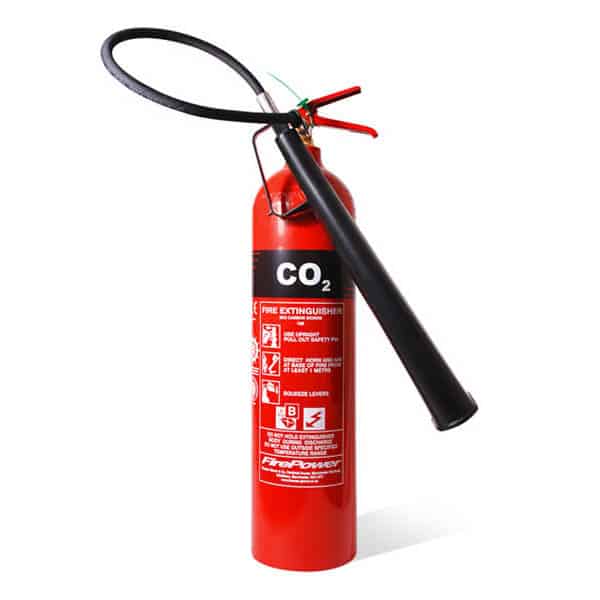
A CO2 fire extinguisher is designed specifically for combating Class B (flammable liquids) and Class C (electrical) fires. Here’s a description of its features:
Carbon Dioxide (CO2) Agent: CO2 extinguishers contain carbon dioxide gas stored under pressure. When discharged, the CO2 gas displaces oxygen, suffocating the fire by removing its oxygen supply. This makes CO2 extinguishers effective for smothering fires involving flammable liquids (Class B) and electrical equipment (Class C) without leaving behind any residue.
Non-Conductive: CO2 extinguishers are non-conductive, meaning they can safely be used on live electrical equipment without the risk of electric shock to the user.
No Residue: Unlike dry chemical extinguishers, CO2 extinguishers leave behind no residue after use, making them ideal for environments where cleanup after extinguishing a fire is a concern, such as in laboratories, server rooms, or sensitive electronic equipment areas.
Limited Cooling Effect: While CO2 extinguishers effectively suppress fires by displacing oxygen, they do not have a significant cooling effect like water or foam extinguishers. This means that re-ignition of the fire is possible if the heat source is not adequately cooled.
CO2 fire extinguishers are commonly seen in areas with electrical equipment, such as offices, server rooms, laboratories, and workshops, as well as in industrial settings where flammable liquids are present. They are recognizable by their red color and horn-shaped discharge nozzle.
BC FIRE EXTINGUISHER
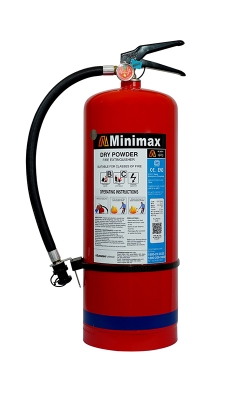
A BC fire extinguisher is specifically designed to combat Class B (flammable liquids) and Class C (electrical) fires. Here’s a description of its features:
Dry Chemical Agent: BC extinguishers typically use dry chemical agents such as sodium bicarbonate (baking soda) or potassium bicarbonate to suppress fires. These chemicals work by interrupting the chemical reaction of the fire and forming a barrier between the fuel and oxygen, effectively extinguishing the flames.
Non-Conductive: Like CO2 extinguishers, BC extinguishers are non-conductive, meaning they can safely be used on live electrical equipment without the risk of electric shock to the user.
Versatility: BC extinguishers are versatile and effective against fires involving flammable liquids (Class B) and electrical equipment (Class C). They are commonly found in locations where both types of fire hazards may be present, such as workshops, garages, kitchens, and industrial facilities.
Limited Cooling Effect: Similar to CO2 extinguishers, BC extinguishers do not have a significant cooling effect like water or foam extinguishers. While they suppress the fire effectively, re-ignition is possible if the heat source is not adequately cooled.
BC fire extinguishers are recognizable by their red color and are often labeled with a BC symbol to indicate their suitability for use on flammable liquid and electrical fires. They are a common choice for general-purpose fire protection in commercial, industrial, and residential settings.
WATER FIRE EXTINGUISHER
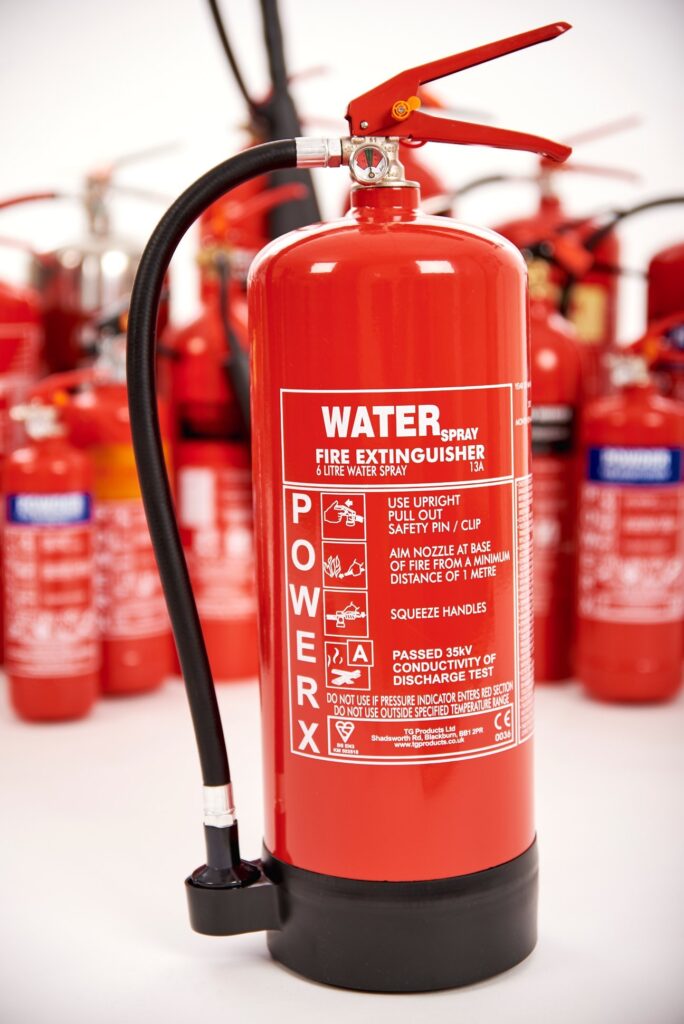
A water fire extinguisher is a traditional type of fire extinguisher that uses water as the extinguishing agent. Here’s a description of its features:
Water Agent: Water extinguishers use pressurized water to suppress fires by cooling the fuel below its ignition temperature and soaking combustible materials to prevent re-ignition. They are effective against Class A fires, which involve ordinary combustible materials such as wood, paper, cloth, and certain types of plastics.
Limited Applicability: Water extinguishers are not suitable for use on fires involving flammable liquids (Class B) or electrical equipment (Class C) since water can spread flammable liquids and conduct electricity, increasing the risk of electrocution.
No Chemical Residue: Unlike dry chemical extinguishers, water extinguishers leave behind no chemical residue after use, making cleanup easier and reducing potential damage to property.
Environmentally Friendly: Water extinguishers are environmentally friendly and non-toxic, making them a preferred choice in settings where environmental concerns are a priority.
Risk of Freezing: In cold environments, water extinguishers may be susceptible to freezing, potentially rendering them ineffective. To mitigate this risk, some water extinguishers are equipped with antifreeze additives or are replaced with water mist extinguishers, which use a fine mist of water droplets to suppress fires without the risk of freezing.
Water fire extinguishers are commonly found in buildings, schools, offices, and other locations where Class A fire hazards are prevalent. They are typically distinguishable by their red color and are labeled with a Class A symbol to indicate their suitability for use on ordinary combustible materials.
FOAM FIRE EXTINGUISHER
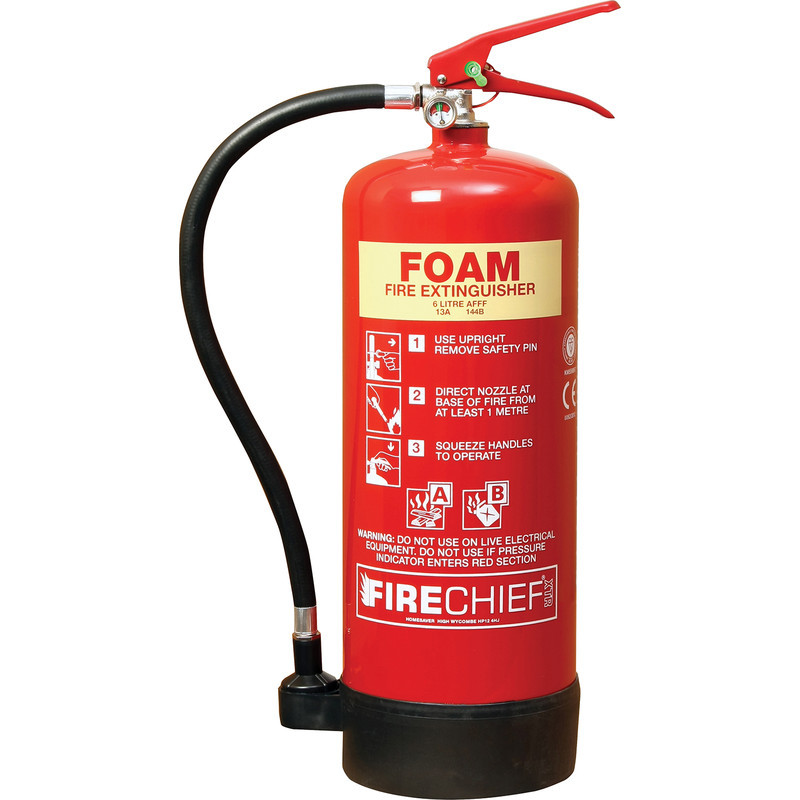
A foam fire extinguisher is designed to combat Class A (ordinary combustibles) and Class B (flammable liquid) fires. Here’s a description of its features:
Foam Agent: Foam extinguishers use a foam concentrate mixed with water as the extinguishing agent. When discharged, the foam expands to form a blanket over the surface of the fuel, smothering the fire and preventing re-ignition by excluding oxygen. The foam also helps to cool the fuel, further aiding in fire suppression.
Versatility: Foam extinguishers are effective against Class A fires, involving materials such as wood, paper, cloth, and plastics, as well as Class B fires, involving flammable liquids such as gasoline, oil, and solvents.
Limited Conductivity: Foam extinguishers are generally non-conductive and can be safely used on Class C fires involving electrical equipment, provided the electricity source is de-energized before application.
Residue: Foam extinguishers may leave behind a sticky residue after use, which can be cleaned up relatively easily compared to some dry chemical agents. However, proper cleanup is still necessary to prevent damage to property and equipment.
Environmentally Friendly Options: Some foam extinguishers use environmentally friendly foam concentrates that are biodegradable and have minimal environmental impact.
Foam fire extinguishers are commonly found in industrial facilities, warehouses, garages, and locations where Class B fire hazards are prevalent. They are often distinguished by their cream-colored bodies and red labels, indicating their suitability for use on both Class A and Class B fires.
CLEAN AGENT FIRE EXTINGUISHER

A clean agent fire extinguisher is designed to suppress fires without leaving behind any residue or causing damage to sensitive equipment or materials. Here’s a description of its features:
Clean Agent: Clean agent extinguishers use gaseous agents that are non-conductive, non-corrosive, and leave no residue upon discharge. These agents work by chemically interfering with the combustion process, effectively extinguishing the fire by removing the heat element.
Non-Conductive: Clean agent extinguishers are safe to use on live electrical equipment without the risk of electric shock or damage to the equipment.
No Residue: One of the primary advantages of clean agent extinguishers is that they leave behind no residue after use. This makes them ideal for protecting sensitive equipment, such as computers, servers, data centers, telecommunications facilities, laboratories, and museums, where cleanup after a fire can be costly or damaging.
Environmentally Friendly: Many clean agents are environmentally friendly and have zero ozone depletion potential and low global warming potential, making them a sustainable choice for fire protection.
Limited Cooling Effect: While clean agents effectively suppress fires by removing the heat element, they do not have a significant cooling effect like water or foam extinguishers. Therefore, there is a potential risk of re-ignition if the heat source is not adequately cooled.
Common clean agents used in fire extinguishers include Halon alternatives such as Halotron, HFC-227ea (FM-200), and HFC-236fa (FE-36), as well as inert gases like nitrogen or argon. Clean agent extinguishers are typically distinguished by their red color and are commonly used in environments where protecting sensitive equipment and materials from fire damage is essential.
MODULAR AUTOMATIC FIRE EXTINGUISHER
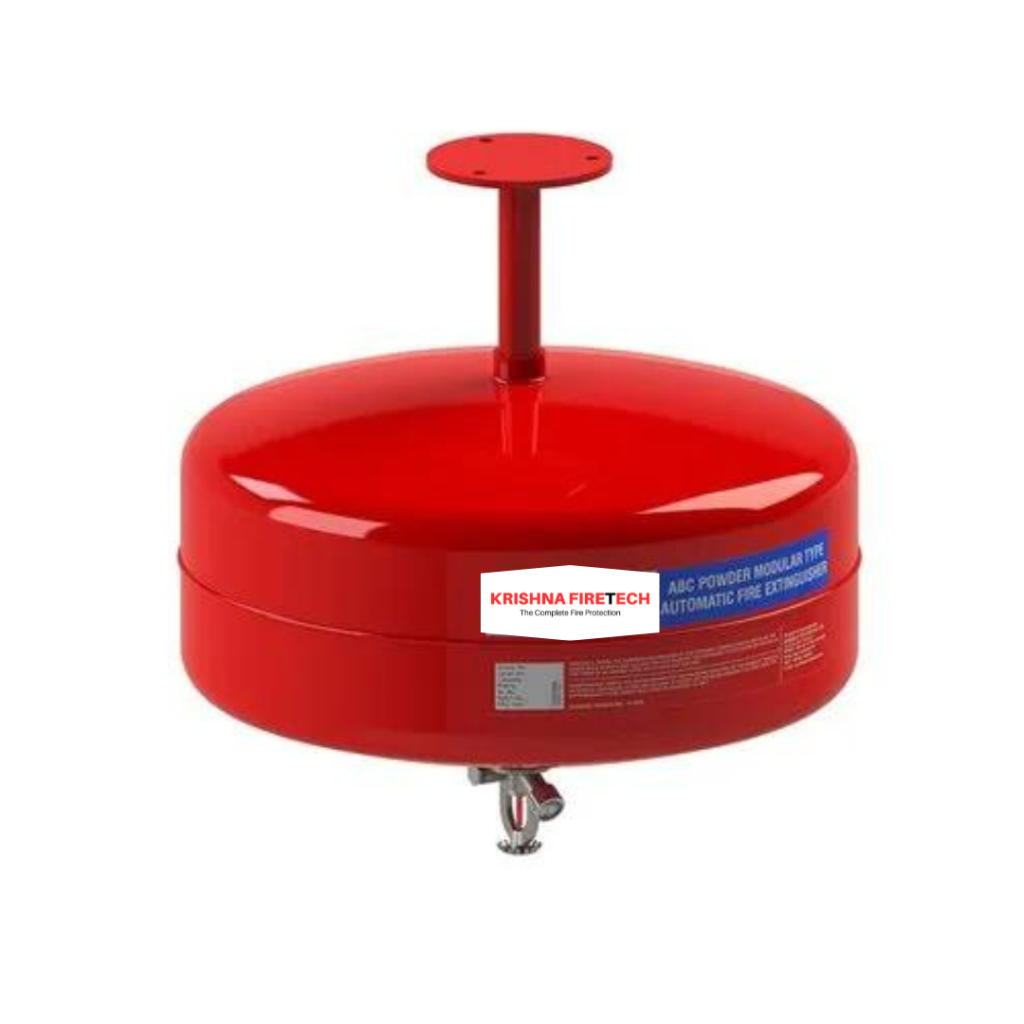
A modular automatic fire extinguisher is a system designed to detect and suppress fires automatically without the need for human intervention. Here’s a description of its features:
Modular Design: The system is composed of modular components that can be configured and installed based on the specific requirements of the environment or application. These modules typically include detection sensors, control units, extinguishing agents, and discharge mechanisms.
Automatic Detection: The system is equipped with sensors that continuously monitor the environment for signs of fire, such as heat, smoke, or flames. When a fire is detected, the system activates automatically without the need for manual intervention.
Suppression Mechanism: Upon detection of a fire, the system releases an extinguishing agent to suppress the fire quickly and effectively. The type of extinguishing agent used depends on the nature of the fire and the requirements of the application. Common extinguishing agents include water mist, clean agents, dry chemicals, or foam.
Localized Protection: Modular automatic fire extinguishers are often installed in specific areas or compartments where the risk of fire is high or where traditional firefighting methods may be impractical. This localized approach helps contain fires before they can spread to other parts of the building or facility.
Integration: These systems can be integrated with other fire detection and suppression systems, such as fire alarms, sprinkler systems, and building automation systems, to provide comprehensive fire protection and emergency response capabilities.
Scalability: Modular automatic fire extinguishers are scalable and can be expanded or modified as needed to accommodate changes in building layout, occupancy, or fire protection requirements.
These systems are commonly used in various applications, including server rooms, electrical cabinets, machinery spaces, kitchens, and other high-risk environments where early detection and rapid suppression of fires are critical for life safety and property protection.
K-TYPE FIRE EXTINGUISHER

A K-type fire extinguisher, also known as a kitchen fire extinguisher, is specifically designed for combating fires involving cooking oils and fats, commonly found in kitchens and cooking areas. Here’s a description of its features:
Wet Chemical Agent: K-type extinguishers typically use a special wet chemical agent specifically formulated to extinguish fires fueled by cooking oils and fats, which are classified as Class K fires. The wet chemical agent works by forming a thick, soapy layer on the surface of the burning oil or fat, which suppresses the fire by cooling and smothering it.
Reactive Properties: The wet chemical agent in K-type extinguishers has reactive properties that help prevent re-ignition of the fire after extinguishment. It also creates a barrier between the hot oil and the surrounding air, reducing the risk of flare-ups.
Low Pressure Discharge: K-type extinguishers are designed to discharge the wet chemical agent at a low pressure to minimize the risk of splashing or spreading the burning oil, which could exacerbate the fire.
Application Wand or Nozzle: K-type extinguishers often come equipped with a long application wand or nozzle that allows the user to apply the extinguishing agent from a safe distance, reducing the risk of burns or injury.
Non-Conductive: K-type extinguishers are typically non-conductive, meaning they can be safely used on electrical appliances or equipment involved in a kitchen fire without the risk of electric shock.
Stainless Steel Construction: Many K-type extinguishers feature a stainless steel construction to withstand the high temperatures often encountered in kitchen environments and to resist corrosion from cooking oils and fats.
K-type fire extinguishers are essential safety devices for commercial kitchens, restaurants, food trucks, and other food service establishments where the risk of cooking oil fires is high. They are often identified by their distinctive color coding, which may vary depending on regional standards but is commonly yellow in many regions.
D-TYPE FIRE EXTINGUISHER
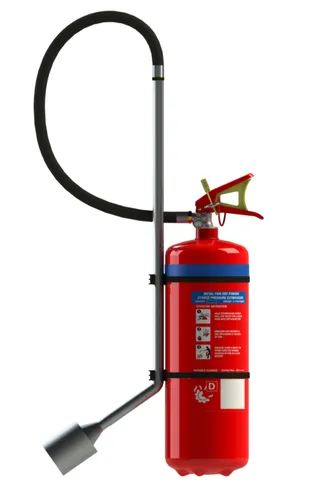
A D-type fire extinguisher is specifically designed to combat fires involving flammable metals, such as magnesium, titanium, potassium, sodium, and lithium. Here’s a description of its features:
Dry Powder Agent: D-type extinguishers typically use a dry powder agent, such as powdered graphite, sodium chloride, or copper-based compounds, that is specifically formulated to extinguish fires involving flammable metals. The powder works by smothering the fire and inhibiting the chemical reaction between the metal and oxygen.
High Discharge Pressure: D-type extinguishers are pressurized to higher levels than standard dry chemical extinguishers to ensure effective penetration of the powder into the burning metal, as fires involving flammable metals can burn at extremely high temperatures and require thorough suppression.
Specialized Nozzle Design: The discharge nozzle of a D-type extinguisher is often designed to provide a high-velocity discharge stream to effectively penetrate the burning metal and distribute the powder evenly over the fire.
Limited Conductivity: The dry powder agent used in D-type extinguishers is generally non-conductive, meaning it can be safely used on fires involving live electrical equipment if necessary.
Specialized Application: D-type extinguishers are not commonly found in general-purpose fire protection applications but are typically used in industrial settings where flammable metals are present, such as manufacturing facilities, laboratories, metalworking shops, and aircraft maintenance areas.
Special Handling: Fighting fires involving flammable metals can be hazardous, and special training is often required to use D-type extinguishers safely and effectively. Improper use of these extinguishers can result in the exacerbation of the fire or the release of hazardous gases.
D-type fire extinguishers are distinguishable from other types by their specific labeling and are typically identified by their color coding, which may vary depending on regional standards but is commonly designated with a blue label in many regions. Due to the specialized nature of fires involving flammable metals, D-type extinguishers are not commonly found in residential or commercial settings but are essential safety equipment in industries where such hazards are present.
